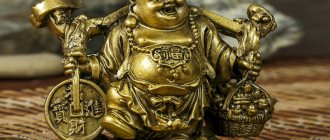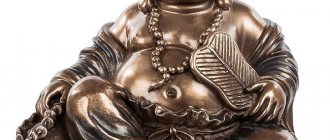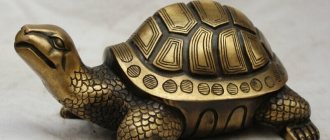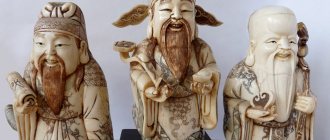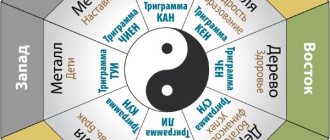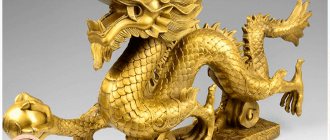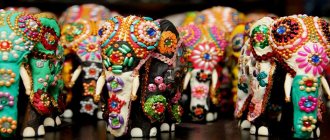One of the key and significant symbols for the teachings of Feng Shui is the figurine of a laughing Buddha. The second name of the Hotei symbol. The figurine is a small figurine of a cheerful and broadly smiling plump man. A single life-size figurine of a fat man necessarily has an addition in the form of a burden in the hands or behind the shoulders and is often located on a stone or some other support.
Who is Hotei?
Hotei (other spellings: Hotei, Hottei, less often - Budai or Bodai) is one of the most respected Japanese gods, which explains his popularity among Feng Shui adherents. Associated with the deity of entertainment and fun, he is considered the patron of non-labor-intensive work, which is nevertheless capable of generating a good income. His unique nickname is the Laughing Buddha, which was given to Hotei for his light, cheerful disposition.
The name of the god Hotei is translated from Japanese as “linen bag.” The god also had a real prototype - the monk Qitsi, who lived in the 10th century and was Chinese by birth. He preferred idleness and fun to deep spiritual quests, which is why he was a regular visitor to crowded fairs, where he predicted the weather and earned his living from it. The monk's nickname - Budai - came from the name of the alms bag, which was his only property. Symbolically, the second bag, due to its enormous size, was also nicknamed Budai’s stomach, in which, according to Chinese beliefs, vital energy, or qi, was concentrated. According to a legend that soon developed, in the places that Budai visited, people began to attract health, happiness and prosperity.
It is for this reason that already in the 15th century, Budai, or Hotei, began to be considered one of the seven gods of happiness in Shintoism, representing the embodiment of serenity and fun.
Interesting read
Phoenix bird talisman - amulet
Another legend says that Budai was not a monk at all, but a turning point occurred in his life that forced him to turn from a handsome, slender young man into an unattractive and fat man. All because one day the feeling of guilt for the broken hearts of the girls took over in the soul of the young man. Being kind and sympathetic, he deprived himself of external attractiveness and vowed to always give people only wealth and happiness in order to atone for his sins.
What does Hotei bring to people?
To this day, God Hotei gives people decent money, helps them achieve success in their careers with minimal effort, and warns against bad decisions and subsequent problems. In his role as the god of abundance, he is also responsible for open respect from others.
It is believed that in general the god Hotei can fulfill any wish of his owner: for this, his figurine, called netsuke, must be located in the house in the right place according to the rules of Feng Shui. To be sure, it is customary to rub this miniature sculpture on the stomach, thinking about what you want. Read more about the rituals below.
How is it portrayed?
Traditionally, the god Hotei is depicted holding in his hands what the owner of the figurine strives for, be it: children, gold bars, money, coins, bags filled with jewelry, etc. He can also hold a donated horse, symbolizing the owner’s luck.
Abhaya mudra - fearlessness
Let's start with one of the most popular hand gestures of the Buddha, called Abhaya Mudra. It bestows the energy of fearlessness. This is a very popular gesture that is found in many home decor items featuring Buddha, be it sculptures, paintings or even candle holders.
Buddha is fearless and protective.
So, what is Abhaya Mudra? "Abhaya" is translated from Sanskrit as "fearlessness." This gesture is performed with the open palm of the right hand extended outward at chest level or slightly above. Looking at this hand gesture of the Buddha, one can feel the energy of protection, peace and a strong sense of inner security. This is a great addition to the Feng Shui of any home.
The best place, according to Feng Shui, for Abhaya mudra is the hallway or living room.
Types and meaning of Hotei figurines
Feng Shui meaning
Based on Feng Shui, we should consider in more detail the meaning of each of the varieties of figurines of the god Hotei:
The already mentioned figurine with a child in its arms acts as a talisman for fertility and the birth of healthy offspring. Its variety is Hotei with children who surround him on all sides.
Hotei, holding a rosary in his hands, is a talisman for those who seek knowledge and strive to improve themselves.
The pearl in the hands of this god is intended to patronize the moral development of the owner of the figurine.
Material well-being is ensured by several figures at once: firstly, this is Hotei on a toad, in whose mouth there is a coin, and secondly, the god Hotei with coins or gold in his hands. If the first one only helps to attract money, then the second one, in addition, teaches how to properly handle these wealth.
A separate talisman for those striving for longevity: the god Hotei, who rests on a staff made of bamboo, and sometimes ginseng, a medicinal Chinese plant.
In life, the wind of change is often necessary. The figurine of the god Hotei with a fan brings positive changes to the life of its owner, additionally bestowing him with luck and wealth.
Career aspirations are patronized by the Laughing Buddha, located inside a sand-colored pyramid, which is filled with coins inside. The god in this image helps to focus on the goal, and subsequently successfully achieve it.
To become as wise as a turtle, and at the same time have the power of a dragon, you can acquire a figurine of the god Hotei sitting on a dragon-turtle. The figurine is primarily responsible for the ability to make profitable deals.
What does Hotei with a bag behind his back symbolize?
Standing apart is the classic figurine of the god Hotei, on which he is represented with a bag behind his back. She is responsible for well-being in all areas of life at once. The fact that the god of fun and carefree carries it with him has its own symbolism: it is believed that Hotei with a bag hides all human difficulties and grief in it in order to leave only the good and pleasant. According to another, opposite version, in this bag he carries happiness and wealth, distributing them to everyone he meets.
What are talismans usually made of?
As for the material from which the talisman is usually made: figurines made of gold, bronze, polystone (i.e. artificial stone), clay, natural mahogany, polyresin, marble chips, sapphires, and emeralds are available for sale. The material does not affect the effect in any way. In China, it is the clay Hotei that is considered traditional. It is believed that only white and gold figurines are truly capable of being reliable talismans.
Dimensions
The size of the god figurine depends on the size of the room and the number of people in it.
So, at home you can get by with one small piece, while in a huge hall, through which many people pass, you need to install a more impressive figurine.
Activation of the talisman
The process of activating the talisman will last no more than a week and can be accelerated with your own efforts: thus, by placing the figurine in a beautiful place, surrounded by flowers and appropriate decor, Hotei will be able to appease.
The god statue should try rubbing his stomach, keeping his deepest desire in mind. With each approach, the number of revolutions can be increased so that by the time the talisman is fully activated, you can reach 300 revolutions per day. With the right approach, the figurine will completely master the powers of the deity.
Mascot material
Naturally, the ideal option is gold. However, the cost of such a figurine will be very high. The souvenir market offers the purchase of figurines made from the following materials:
- plastic;
- wood;
- glass;
- polystone;
- marble chips;
- amber;
- bronze;
- natural or synthetic stone;
- precious rocks such as sapphire, emerald and so on.
Preference should be given to one or another mineral, based only on the requirements of the owner. This cannot affect the effect.
Where to place a figurine in a house according to Feng Shui
Where should the god of wealth Hotei be placed in the house? As with the appearance of the figurine, it all depends on the purpose:
A person who strives for prosperity should place a wisher in the south-eastern part of his office. If there is no office, the bedroom can play its role.
Dreaming of family happiness, a precisely selected Hotei should be seated opposite your bed.
When trying to possess wealth, the talisman is left not far from the jewelry box.
To gain honor and respect from others, the god can be placed facing the front door.
If there are few or no children in the family, it is necessary to leave the god Hotei in the wisdom zone - according to Feng Shui, the northeastern part of the room. By itself, the energy of this zone is conducive to making important decisions, self-improvement and spiritual development, and, supplemented by a god, it will be responsible for family fertility.
Mudra Varada - compassion, sincerity and fulfillment of desires
Varada Mudra expresses the energy of compassion, liberation and benefit. This mudra is done with the left hand and is most often seen in combination with other mudras such as Bhumisparsha or Abhaya.
Compassion, sincerity and fulfillment of desires.
This mudra is also called the blessing mudra because it helps impart certain qualities to the energy that are unique to an enlightened being. Often a sacred image, such as a mandala or an eye, can be seen on the palm of the Buddha. This expresses the powerful energy emanating from the enlightened being through his hands.
The best place, according to Feng Shui, for the Buddha showing Varada Mudra is the northwest corner of the house or office.
Top 6 rituals and ceremonies
For wealth:
It is performed when the god Hotei is previously placed in the south-eastern zone of the office, since it is this position that helps to become lucky in money. Every time before leaving home for work, especially before important meetings and negotiations, you need to rub Hotteya’s stomach, consistently increasing the number of revolutions day after day. Important: the ritual is not performed if the owner of the figurine is not feeling well or is in an unwell state of mind.
Interesting read
Elephant with trunk talisman - amulet
For all the blessings of life:
| Transliteration of Sanskrit | Russian transcription | Characteristic |
| AUM GAM GANAPATAYE NAMAH <…></…> | Om gam ganapataye namaha saranam ganesh | It has the power to encourage one to overcome all life’s obstacles and gives a person purity of intentions. |
For love:
| Transliteration of Sanskrit | Russian transcription | Interpretation |
| Jai radha madhav Jai kunj vihari Jai gopi jana vallabh Jai gire balihari | Jaya radha-madhava Jaya kunja-bihari Jaya gopi-jana-valabha Jaya giri-vara-dhari | Absolute perfection of life. |
Mantra for fulfilling wishes for health:
| Transliteration of Sanskrit | Russian transcription |
| OM TARE TU TARE TURE MAMA AH YUH PUNE JANA PUTIM KURU SOHA/SVAHA | Om tare tutare ture mama ayu punye jnana pushtim kuru soha |
Interpretation:
“Punye” or “punya”: a person’s merits in the moral field, capable of generating good karma.
Jnana or Gnana literally means wisdom.
"Pushtim" symbolizes the increase of something.
The name “Kuru” was borne by the legendary country, supposedly located north of the Himalayas. Also “kuru” is the imperative form of the verb “to do”, “to do”.
“Mom” is the reflexive form of the pronoun “I”. To wish health not only to yourself, but also to your loved ones, the name of another person should be placed in place of this word.
“Svaha” or “plow” is an enthusiastic exclamation, the meaning of which can be conveyed to our “so be it.”
Gayatri is a powerful mantra for fulfilling desires and goals.
| Transliteration of Sanskrit | Russian transcription | Interpretation |
| Oṃ bhūr bhuvaḥ svaḥ Tat savitur vareṇ(i)yaṃ Bhargo devasya dhīmahi Dhiyo yo naḥ pracodayāt. | Om bhur bhuvah swah tat savitur varenyam bhargo devasya dhimahi dhiyo yo nah prachodayat. | Awareness and acceptance of divine power, devotion and worship of the Creator. |
Interesting read
Turtle talisman, meaning
A universal ritual that allows you to get to know your patron better and ask him for what you want:
This is not carried out immediately after purchasing the figurine, but a few days later. Your request should be stated in detail and clearly in writing on a piece of paper. Laughing Buddha welcomes ironic writing because he loves cheerful people. A note folded into a small envelope should be tied with two threads, preferably red and gold. Begin the ritual of offering itself: light aromatic candles, sit relaxing in front of the figurine, after offering it some treats - for example, dried fruits, rice or nuts. All you have to do is put your note under the person you want and clearly imagine what you want in your head.
Uttarabodhi Mudra - Highest Enlightenment
Uttarabodhi is called the mudra of supreme enlightenment. It is formed by both hands located in the area of the heart. The index fingers touch each other and point upward, the remaining eight fingers intertwine.
Internal unity.
Such a gesture of the hands clearly evokes a feeling of unshakable unity within oneself. If you try to perform the Uttarabodhi mudra for a couple of minutes, you can feel a subtle energetic shift in the body.
Uttarabodhi Mudra would be best placed in the north or south of your home or office. You can also try placing it in a prominent, high-energy place in your living room.
